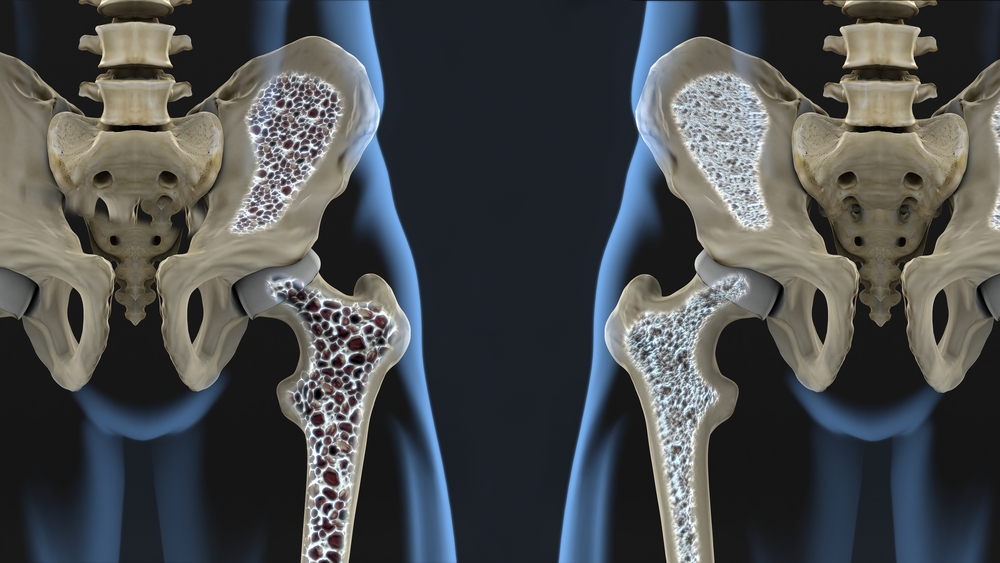Osteoporosis, best explained by breaking down the word ‘Osteoporosis’ meaning ‘reduced bone density’, is a medical condition in which bones become weak and brittle. This thinning of bones and weak bon..
Osteoporosis, best explained by breaking down the word ‘Osteoporosis’ meaning ‘reduced bone density’, is a medical condition in which bones become weak and brittle. This thinning of bones and weak bone crystals put the person at a greater risk of getting bone fractures. This condition can affect any gender, but is more prevalent in women who have crossed menopause. As per a report from National Osteoporosis Foundation, a healthy bone has an architecture similar to a honeycomb. In comparison, a bone with low density will have larger holes compared to a healthy bone.

The early stage of loss of bone has typically no symptoms. But as it progresses, signs begin to show. The major symptoms of this disease are:
- Persistent back pain.
- Difficulty in standing for long periods.
- Fractures, or a collapsed vertebra.
- Bending spinal cord causing loss of height and change of body posture.
- Bone fracture that may occur more easily and rapidly even with slightest of shock.

Osteoporosis occurs when the rate of formation of new bone is lower, as compared to wear and tear being caused. The major causes of this disease are:
- Loss of bone density in case of pregnancy, delivery, and lactation.
- Reduction of generation of oestrogen.
- Prolonged use of oral corticosteroids under high dosage.
- Medical conditions like inflammation, hormone imbalance, malnutrition, and low calcium absorption by body.
- A family history, particularly hip fracture of any one parent.
- Long term use of medications which affects bone density or hormone balance.
- Lower body mass index (BMI).
- Smoking and alcohol consumption.

Factors and certain habits that increase the risk of the disease are:
- Sex - Women are much more likely to develop osteoporosis than men.
- Age - The older you get, the greater the risk of osteoporosis.
- Race – You are at greatest risk of osteoporosis, if you are a Caucasian or of Asian descent.
- Family history - Having a parent or sibling with osteoporosis puts you at a greater risk, especially if your mother or father experienced a hip fracture.
- Body frame size - Men and women who have small body frames tend to have a higher risk because they may have less bone mass to draw from, as they age..
- Hormone levels - Too much or too less of certain hormone types may pose a risk for the disease.
- Dietary - Eating disorders or a surgery that limited the amount of surface area available to absorb nutrients, including calcium.
- Medications and steroids: Prolonged use of oral or injected corticosteroid medications such as prednisone and cortisone, interferes with bone building.
- Lifestyle – Sitting for a long time, regular consumption of alcohol, and tobacco intake.
- Other diseases such as celiac disease, inflammatory bowel disease, kidney or liver disease, cancer, lupus, multiple myeloma, rheumatoid arthritis affect nutrient intake and normal body functioning.

To prevent the occurrence of this disease, these are certain things one should take care of:
- Weight bearing exercises.
- Diet rich in calcium and Vitamin D.
- Adopting a healthy lifestyle.
Our superspecialist doctors provide the highest quality of care through a team-based, doctor-led model. Trained at some of the world's most renowned institutions, our highly experienced doctors are distinguished experts in their respective specialities. Our doctors work full-time and exclusively across Medanta hospitals. In addition to offering superspecialised care in their own field, the Medanta organisational structure enables every doctor to help create a culture of collaboration and multispecialty care integration.
Our superspecialist doctors provide the highest quality of care through a team-based, doctor-led model. Trained at some of the world's most renowned i..... Continue Reading


